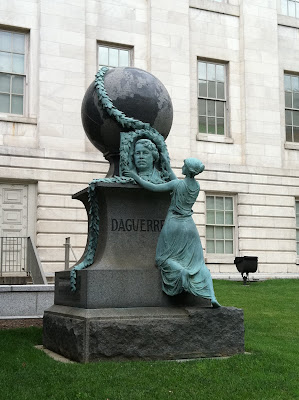 This monument to Louise Daguerre stands outside of the Smithsonian Museum of American Art and American Portraiture, which I may have mentioned a few times...as where I often spend my days. For some reason, I had never noticed this monument to Daguerre until a few days ago, which is pretty odd considering that a good portion of my time at the museum is spent researching photography.
This monument to Louise Daguerre stands outside of the Smithsonian Museum of American Art and American Portraiture, which I may have mentioned a few times...as where I often spend my days. For some reason, I had never noticed this monument to Daguerre until a few days ago, which is pretty odd considering that a good portion of my time at the museum is spent researching photography.As his name suggests, Louis Daguerre was the inventor of the daguerreotype, one of the earliest methods of photography. Daguerre worked on his method throughout the 1830s and finally presented it to France's Académie des science in 1839. The daguerreotype was heralded as a wonder of modern science, but it was also looked at with skepticism and explicit paranoia. What if someone takes a daguerreotype of you--Does that image belong to you or the daguerreotypist? This was at a time when privacy was closely associated with social status. Well-bred people didn't expose themselves to public scrutiny. What if your image was used in something really vulgar like a placard for soap or some medicinal tonic. There would be a scandal!
But not nearly as notorious as the scandal that was reported only a few months after the daguerreotype process was revealed, in which a French gentleman claimed to have made a daguerreotype of his young wife with her lover. Incroyable! Photography could be used as evidence in cases of infidelity. Comment dit-on en francais "Gumshoe?" One of the most remarkable things about this case is that the daguerreotype was accepted as evidence, apparently, without even being seen. What no one stopped to consider is that the exposure time for a daguerreotype meant that the subject, if human, had to remain very, very, very still. If the Frenchman had managed to capture the tryst, the image would be blurry at best.
The process of producing a daguerreotype was extremely complicated and required constant exposure to any number of lethal chemicals. It consisted basically of a glass plate covered in silver alloy, which was treated with chemicals that made the alloy photosensitive. The result was a strikingly detailed image. The closer the plate was to the aperture in the daguerreotype camera box, the smaller the surface of the plate would be exposed to light, and the less defused the light would be; that is, the smaller the image, the more detailed. There is one story of a photographic plate that looked as though it had a speck of dust or a small scratch, but when examined with a microscope, it was a perfect portraiture. The implications were immediate. Spies could transport glass plates with microscopic reproductions of documents or maps, all in the guise of a photographer. If questioned, they would be found only with seemingly unexposed plates. Or, perhaps less intriguing, Britain's entire public archive could be stored on a few glass plates. The possibilities were endless.
When Fox Talbot, an English inventor, heard of of the daguerreotype, he announced his own simultaneous invention, which he had been keeping private. Talbot perfected his process for many years, introducing the first photographic negatives. Daguerreotypes were metal plates; they couldn't be reproduced. Talbot's negatives (The term was coined much later.) could be used to reproduce multiple prints on paper. The daguerreotype enjoyed some popularity in the United States, but within the UK, its success was short lived, and the daguerreotype soon disappeared, along with its characteristic fine details, which were lost until well into the 20th century.
See, I told you, super nerdy.
Most interesting. Nerdy? Well, maybe just a smidgeon. But, we are all nerds at least a smidgeon.
ReplyDeletehaha thanks for understanding, Jack!
ReplyDelete